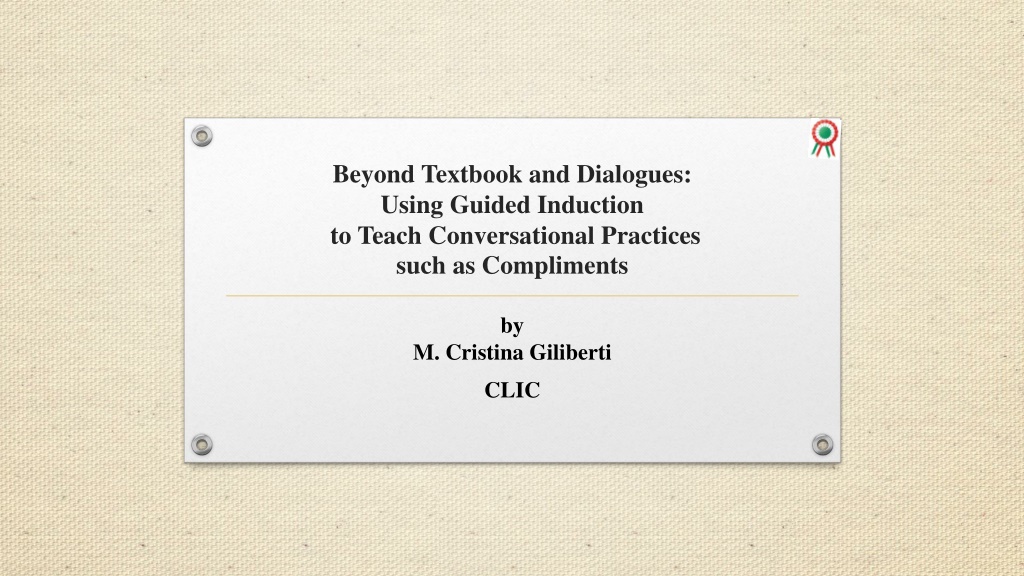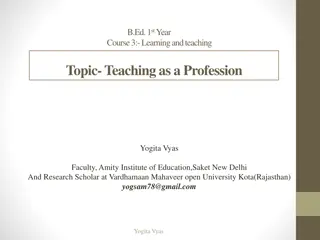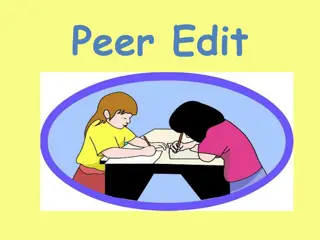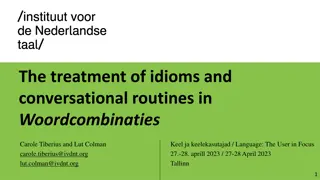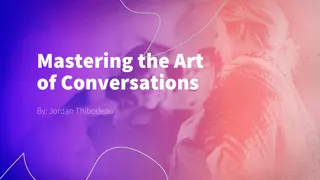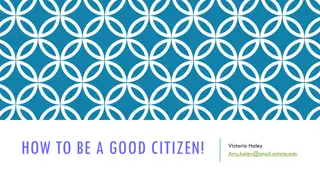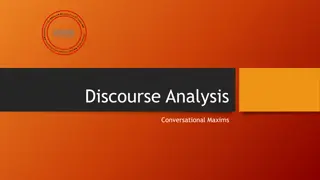Teaching Conversational Practices Through Compliments
Using guided induction to teach conversational practices such as compliments can enhance social interaction and language learning. This approach involves reflecting on textbooks, tools for teaching compliments, and implementing lesson plans to raise students' awareness of language. By leveraging authentic data and dialogues, students can practice identifying and using compliments effectively.
Download Presentation

Please find below an Image/Link to download the presentation.
The content on the website is provided AS IS for your information and personal use only. It may not be sold, licensed, or shared on other websites without obtaining consent from the author. Download presentation by click this link. If you encounter any issues during the download, it is possible that the publisher has removed the file from their server.
E N D
Presentation Transcript
Beyond Textbook and Dialogues: Using Guided Induction to Teach Conversational Practices such as Compliments by M. Cristina Giliberti CLIC
Why compliments?? Compliments are a social glue Play a number of key social and discourse roles: establish friendship that creates ties of solidarity openers for a conversation allow meaningful social interaction to follow
The Textbook: Arrivederci! 2 for English speakers, F. Colombo, C. Faraci, P. De Luca, Edilingua, 2013
Reflection on the textbook: Is my textbook adequate? Do you see any incongruities? How about contextualization? Is anything missing?
My bag of tools to teach compliments Functions Syntactic pattern and lexical items Social components
Becoming aware of our own language by collecting and examining literature resources; gathering and observing authentic data.
Lessonplan Step 1 Raise awareness of student s own language Students complete the charts by using their responses to the practice given in Worksheet 1
Step 2 Introducing L2 dialogues Students are given a dialogue in Italian to read (Worksheet 2). Then they are asked to work on the following practices:
Group work Identify and underline any form of compliment you find in the dialogue. Then fill the Functions Chart with your answers Functions Chart positive evaluation greet or open a conversation, express gratitude, close a conversation, preface a request, positively reinforce desired behavior, soften criticism, assessment. ____________________________________ ____________________________________ ____________________________________ ____________________________________ ____________________________________ ____________________________________ ____________________________________ ____________________________________ Students answers are corrected in plenum
Step 3 Categorizing compliments strategy Students fill in the chart they have used in Step 1 with the examples of compliments they have found in the previous practice
Worksheet 3 Fill in the following chart with the compliments you have identify from the dialogue in the previous step. Type Praise of performance / skills Example Head act strategy Praise of possession Praise of appearance Internal modifier Superlative Intensifier Exclamation Repetition External modifier Preparator
Reflection: Reflect on your findings by answering the following questions: Which syntactic and lexical items are more frequent and recurring in the formulation of the Italian compliments you have found? verbs ________________________________________________________ adjectives _____________________________________________________ modifiers ___________________________________________________ Do any compliments for each situation seem inappropriate to you? If so, why? ____________________________________________________________________________________ ____________________________________________________________________________________ ____________________________________________________________________________________ Would you have uttered in your language the same compliments in a different way? If so, how? ____________________________________________________________________________________ ____________________________________________________________________________________ ____________________________________________________________________________________
Step 4 Categorizing Compliment Responses strategy Students work on Compliment Responses: they first highlight them and subsequently they focus their attention upon the typology
Worksheet 4 Underline the compliment responses you find in the Italian dialogue. Then fill in the following chart listing the type of responses you have found. Type Token of appreciation Example Head act strategy Downgrading Disagreeing Avoiding the topic Questioning or requesting assistance Shifting the credit
Reflection Reflect on your findings by answering the following questions: What is the prevalent strategy used in responding to a compliment? Have you noticed any difference between Italian and English in the way compliment responses are uttered? Can you think of any cultural differences that may have determined the dissimilarity in compliment responses?
Step 5 A) Practicing with compliments Students are asked to complete a dialogue in Italian and then they listen to the recorded version and correct their answers
Che belle scarpe! D: ____ _______________ scarpe che hai comprato! (Praise of possession: exclamation) _____ ___________! (Internal modifier: superlative) C: Mah, ___________ queste? (Compliment responses: downgrading) D: Si , si sono __________ come le volevo io: alte, bianche, con l abbronzatura al piede (intensifier) C: [Senti io D: sono ___________! (Internal modifier; superlative) C: Senti io, veramente, queste scarpe me la hanno regalate. Eh:::, sono commode, pero io le trovo _____ particolarmente _________ (Compliment response: downgrading). Se vuoi te le chiedo alla mia amica dove le ha prese e te le faccio prendere.
B) Practicing with compliments Students are asked to write a conversation in Italian between two friends. One of the two compliments the other about the after-lunch coffee she has made. Subsequently students listen to the recording of an authentic conversation in Italian and compare their answers with the original dialogue.
I Complimenti nella Conversazione, Giovanna Alfonsetti, Editori Riuniti university press, 2009 Comparing Textbooks and TV Series as Sources of Pragmatic Input for Learners of Italian as Second language: the Case of Compliments and Invitations, Elena Nuzzo in Teaching Learning and Investigating Pragmatics, Gesuato, Bianchi, Cheng, Cambridge Scholars Publishing, 2015. The Variability of Compliment Responses: Italian and German Data, Marina Castagneto and Miriam Ravetto, in Teaching Learning and Investigating Pragmatics, Gesuato, Bianchi, Cheng, Cambridge Scholars Publishing, 2015. Have You Paid Someone a Compliment Today?, Jessie Carduner, in Pragmatics: Teaching Natural Conversation, N. R. Houck and D. H. Tatsuki, Tesol, 2011. Male and female Complimenting Behavior, Anne McLellan Howard, in Pragmatics: Teaching Natural Conversation, N. R. Houck and D. H. Tatsuki, Tesol, 2011.
e grazie!!!! e grazie!!!!
